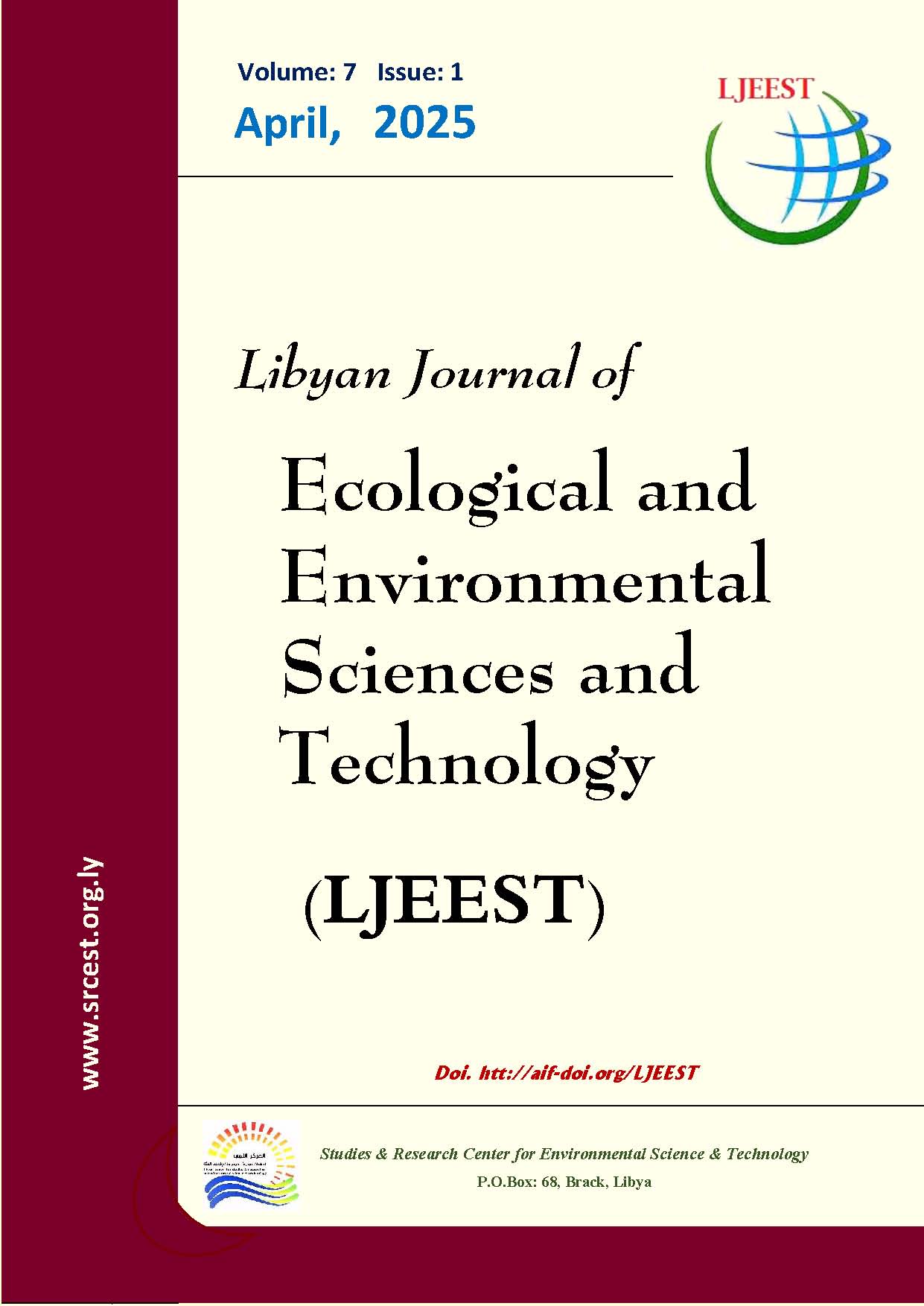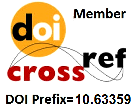Environmental Assessment of Leishmaniasis Endemicity Through Entomological and Ecological Surveillance in Brak and Surrounding Regions, Libya
DOI:
https://doi.org/10.63359/tpr2jy79Keywords:
Leishmaniasis, Sand fly, Leishmania parasite host, Rodents, Insects, Endemicity Surveillance, LibyaAbstract
This study was conducted to assess the environmental status of leishmaniasis in Brak and its surrounding areas. The locations of infection were identified based on patient records from health units in the Brak region. Sample collection took place from the beginning of September to the end of December 2023 through field visits to areas where initial cases of leishmaniasis were reported, specifically Ishkida, Brak, and Tamzawa. These visits were carried out in collaboration with the Rapid Response and Surveillance Team, with each area being visited three times. Regarding vector collection, sand flies were captured using traditional sticky paper traps. These traps were deployed in mosquito-prone zones, suspended from plant branches at a height not exceeding 1 meter above ground level. The collected insects were identified and classified accordingly. For rodent sampling, Tongde-brand sticky traps were used. These traps featured adhesive layers on both sides and were baited with attractants specific to rats and mice. The findings indicate that the study area is endemic for the sand fly vector responsible for transmitting leishmaniasis. The environmental conditions in the region are conducive to the proliferation of wild rodents that act as reservoirs for Leishmania parasites, as well as to the survival and distribution of associated insect vectors. Transmission typically occurs when female sand flies feed on the blood of animals and humans.
The results of the current study align with those reported by the Libyan Center for Disease Control and Surveillance in 2021, which documented leishmaniasis cases in Ishkida and Brak. Sand flies were observed 6 and 4 times respectively in Ishkida and Brak. However, the findings did not align with Tamzawa, where no sand flies were recorded. The entomological survey in the study regions revealed the presence of various insect species, including mosquitoes, moths, fleas, lice, tsetse flies, “Tanfush” bugs (likely local naming), house flies, ants, grain moths, and hide beetles. In addition, rodents—recognized reservoirs of the parasite—were observed in Ishkida and their traces were detected in Brak. However, no rodents or their traces were found in Tamzawa during the collection period. In conclusion, the study area is confirmed as an endemic zone for the sand fly vector of leishmaniasis, with favorable environmental conditions for the persistence and proliferation of rodent reservoirs and associated insect vectors, whose distribution is closely linked to the presence of the sand fly.
References
الزنتاني، ايمان (2019).تعريف و وصف لذبابة الفاكهة المصاحبة لعوائل مختلفة من أشجار الفاكهة في بعض بساتين طرابلس. مجلة جامعة مصراتة للعلوم الزراعية.المجلد الأول العدد الأول.
حبيب،م.زينب (2013) كتاب معجم مصطلحات علم الحيوان . دار أسامة للنشر التوزيع عمان( ص513).
شنيييش،أ.أريج (2021).دارسة تصنيفية لبعض أنواع ذباب الرمل المتواجد في منطقتي صرمان وصبراتة . scientific Journal of Applied Sciences of.Sabrath University,185-194
دسوقي ،س. عبدالعليم و سيد ،ع. عبدالوهاب (2017).القوارض (تصنيفها- صفاتها المورفولوجية سلوكها ومكافحتها)(ص4-ص12).
مركز الرصد والتقصي والاستجابة السريعة الشاطئ(2021) تقرير متابعة حالات اشتباه بمرض اللشمانيا . https://ncdc.org.ly
Acevedo, G., Boscaro, I., and Toloza,. C. (2023). Global pattern of kdr-type alleles in Musca domestica (L.). Current Tropical Medicine Reports, 10(1), 1-10.
Berrizbeitia,F.,and Theya,M(2019).Siphonaptera associated with small mammals (Didelphimorphia, Chiroptera,and Rodentia) from northwestern Argentina.10(3),279-308.
Chatterjee, A., Majhi, S., Calcagno, V., and Brémond, F. (2023). TrichANet: An Attentive Network for Trichogramma Classification. In VISIGRAPP (4) 864-872.
Coller LH, Sussman M, Balows A, Mahy BWJ. (1998).Topley and Wil-son's Microbiology and Microbial Infections. 9th ed. Vol 5, Para-sitology. London. Arnold..
Durden,A. (2019). Lice (Phthiraptera). In Medical and veterinary entomology .Academic Press. (79-106).
El-Buni AA, Jabeal I, Ben-Darif AT (2000). Cutaneous leishmaniasis in the Libyan Arab Jamahiriya: a study of the Yafran area. East Mediterr Health J; 6: 884-887.
Foster, A., and Walker, E. D. (2019). Mosquitoes (Culicidae). In Medical and veterinary entomology. Academic press. (261-325).
Gibernau, M., and Albre, J. (2022). First insights on the diversity of the genus Psychoda Latreille (Diptera: Psychodidae) in Corsica using DNA barcoding. In Annales de la Société entomologique de France 58, ( 1). 81-91. Taylor & Francis.
Johnson, F., and Triplehorn, A. (2004). Borror and DeLong's introduction to the study of insects 7th edition.
Joshi, R., Pathania, C., Das, A., Mazumder, A., Ranjan, R., and Singh, N. (2021). Insecta: Lepidoptera: Heterocera (Moths). Faunal diversity of biogeographic zone of India: North-East. Published by the Director Zoological Survey of India, Kolkata, 511-576..
Lainson R.(1988) Ecological interactions in the transmission of the leishmaniasis. Philos Trans R Soc Lond B Biol Sci; 321:389-404.
Lainson,R., Rangel EF:(2005) Lutzomyia longipalpis and the eco-epidemiology of American visceral leishmaniasis, withparticular reference to Brazil: a review. Mem Inst Oswaldo Cruz, (100)811-827.
Manal .Z.M.A, Khamis .E, Ewis .A .A. An . (2013). Epidemiological Study of Cutaneous Leishmaniasis in Al-Jabal Al-Gharbi, Libya;The Korean Journal of Parasitology 51(1):75-84.
Markell EK, John DT, Krotoski WA. (1999).Markell and Voge's medical parasitology. 8th ed. Philadelphia, USA. WB Saunders.
Momcilovic , C. Cantacessi,. Arsenijevic, D. Otranto, S and Tasic Otasevic . (2019) Rapid diagnosis of parasitic diseases: current scenario and future needs. Clinical Microbiology and Infection 25 (3), 290-309.
Postigo JA. (2010).Leishmaniasis in the World Health Organization Eastern Mediterranean Region. Int J Antimicrob Agents; 36:S62-S65.
Thomas, A., Frandsen, B., Prendini, E., Zhou, X., and Holzenthal,W. (2020). A multigene phylogeny and timeline for Trichoptera (Insecta). Systematic Entomology, 45(3), 670-686.
Tropical Council on Companion Animal Parasitology (TroCCAP), (2022). Guidelines for the control of ectoparasites of dogs and cats in tropical areas. TroCCAP, 1st ed.
Vaca, A., Silva-Medina, M., and Escandón-Vargas, K. (2015). Bedbugs, Cimex spp.: their current world resurgence and healthcare impact. Asian Pacific Journal of Tropical Disease, 5(5), 342-352.
Vreysen, M., Seck, M., Sall, B., Mbaye,. G., Bassene, M., Fall, A., and Bouyer, J (2021). Area-wide integrated management of a Glossina palpalis gambiensis population from the Niayes area of Senegal: A review of operational research in support of a phased conditional approach. Area-Wide Integrated Pest Management, 275-303.
Zhang, Q. (2011). Animal biodiversity: An outline of higher-level classification and survey of taxonomic richness. Magnolia press.
Zyla, D., and Solodovnikov, A. (2020). Multilocus phylogeny defines a new classification of Staphylininae (Coleoptera, Staphylinidae), a rove beetle group with high lineage diversity. Systematic Entomology, 45(1), 114-127.
Downloads
Published
Issue
Section
License
Copyright (c) 2025 Libyan Journal of Ecological & Environmental Sciences and Technology

This work is licensed under a Creative Commons Attribution-NonCommercial 4.0 International License.














